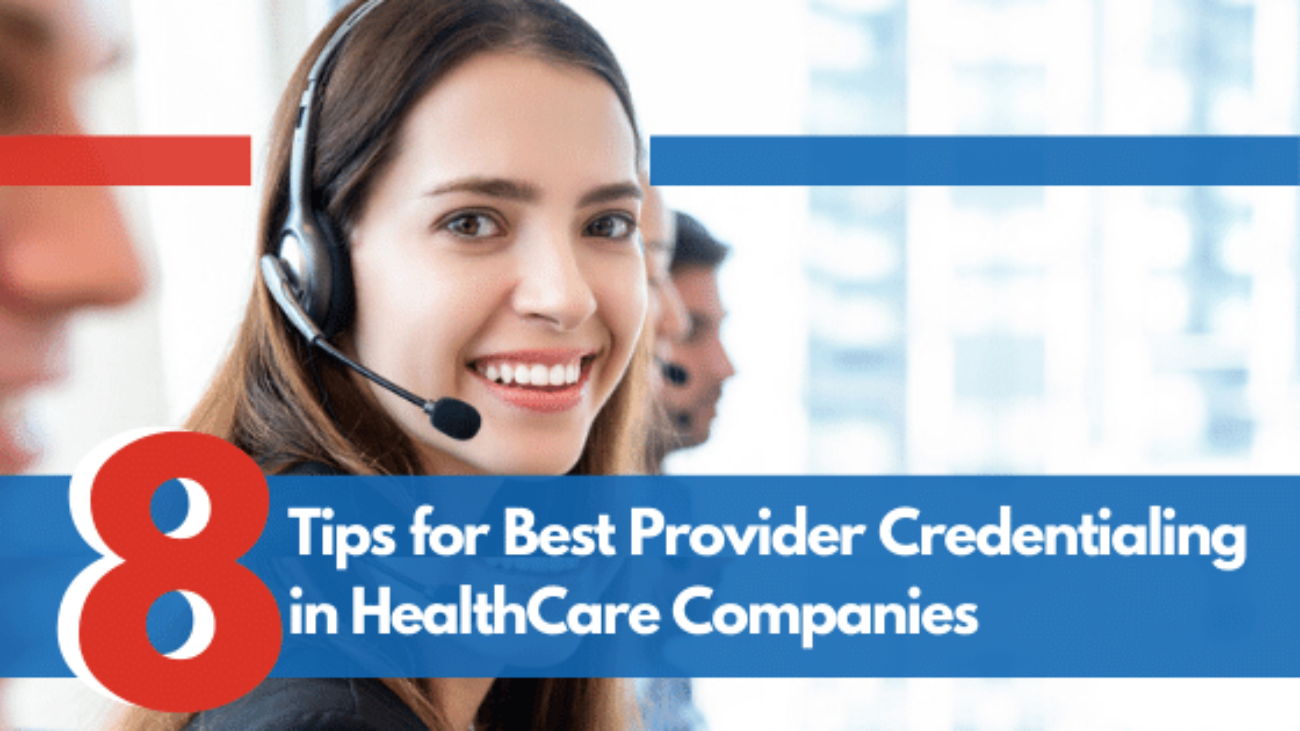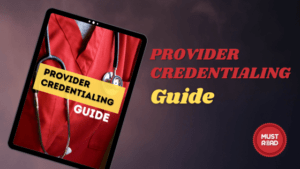Do you agree that Provider Credentialing in revenue cycle management companies shows great impact on revenue generation?
The reports say “Yes”! Provider Credentialing has become vital and essential for revenue cycle management companies in order to maintain their standard of services.
What is Provider Credentialing?
- Provider Credentialing is a pioneer to contracting and becoming trusted healthcare professionals by numerous insurance companies.
- It’s an opportunity for the healthcare providers to expand their patient list with specialized insurance plans.
- Credentialing process is majorly used by the healthcare departments for hiring and allowing the healthcare professionals to participate in the insurance companies’ network.
- It also involves the process of verifying skills, education and practice of healthcare providers.
- Credentialing a healthcare provider based on qualification, work and certifications are significant for all healthcare organizations.
- Revenue cycle management companies offer provider credentialing services available to patients as well as insurance companies by making provider’s and payer’s work more comfortable and convenient.
- Usually, it consists of two processes, they are:
- Privileging
- Provider Enrollment
- Privileging process approves healthcare professionals for performing certain specific set of procedures.
- Provider Enrollment is the addition of new healthcare providers into the organization’s payer plans to ensure correct and complete payment for their services provided.
8 Tips for Successful Provider Credentialing Process:
- Early Start
- Cloud Based Technology Platform
- Motivating New Providers
- Five References
- Be Proactive
- Outsourcing Credentialing services
- Detailing issues can cause Delays
- Familiarizing Credentialing Regulations
-
Early Start:
- Start the Provider credentialing process as early as possible.
- Be prepared with the provider documents such as CV, email references, phone numbers etc. prior to the scheduled time.
- However, it’s evident that some insurance companies accept credentialing a new provider until 60-90 days before starting the work.
-
Cloud Based Technology Platform:
- Cloud Based Technology allows providers and healthcare organizations to access the healthcare professional’s data at any location and time.
- Unlike client server-based, storing the data or the information and accessibility is much efficient and affordable.
-
Motivating New Providers:
- Taking longer duration for Credentialing new providers actually impacts on the healthcare practice’s revenue and sometimes brings loss.
- Accurate submission of documents and information is required to start the credentialing which will be no sooner than 120 days.
-
Five References are Important:
- Most of the insurance companies expect and require minimum three references to start the approval process.
- Any lagging would delay the whole process. So, it’s always recommended to have five references to keep everything on track and prevent delays.
-
Be Proactive:
- Timing is very important to keep the track on process by noticing when the application is sent and as well as following up weekly.
- It can often expedite and keep updated with the approval status.
-
Outsourcing Credentialing services:
- Outsourcing credentialing services to the revenue cycle management companies can navigate and understand the routine credentialing process.
- It can reduce the credentialing waiting times by days or weeks with frequently having 60 days between hiring and start scheduling dates which is a great time saver.
-
Detailing Issues can cause Delays:
- Most of the insurance companies reports that three in four applications are rejected or delayed due to mistakes.
- It’s very important to give accurate details in the first place at first time of the submission.
- Revenue cycle management companies who can provide better provider credentialing services can immediately spot problems easily and work effectively to quickly resolve things.
-
Familiarizing Credentialing Regulations:
- Few States permit reciprocating the credentialing services from one State to the another.
- Additionally some States also allow the bills for the services provided during the credentialing process which is not common for all.
- It’s very essential and crucial to know and make sure if the applicable regulations are used according to the provider’s advantage.
Common Causes for the Delays:
- Incomplete work history and failed to explain the time lapse of 30 or more days.
- Incomplete proof of coverage along with the start date of practice and also incomplete malpractice history.
- References less than three and some references go missing.
- Uncovered hospital privileges.
- Expired or outdated information in the credentialing database.
Pitfalls Encountered in Provider Credentialing process:
- Inaccurate information from non-interoperable systems instead of using cloud based platform.
- Processing delays from inaccurate and missing information such as work history, required for insurance companies before reimbursement reimbursements.
- Miscommunication and failed communications between all departments, finance, IT and payers as well as medical departments staff to keep credentialing services running smoothly.
Advantages of Outsourcing credentialing services to RCM companies:
- It reduces the operational costs to around 30-40%.
- Eradicate errors and mistakes that could lead to enrollment delays.
- Opportunity to hire more experts to work effectively and efficiently.
- Involves staff in the indigenous work of billing and collections.
- Saves time and paperwork.
Important steps of Provider Credentialing:
-
Application Process:
- Submitting the application is the first step of achieving network status.
- Application submission must be in the updated version of the insurance companies form.
- Outdated or expired version can lead to delays and denials.
- All the sections in the application forms should be filled and completed.
- Any mistake would delay the process and if required, cross check the application before submission.
- Have a copy of all the credentialing application materials.
-
Add all Relevant Information:
- Providing complete details regarding medical malpractice is important.
- Regular check ups will be followed by the insurance companies and any missed or failed information will delay the application or sometimes get denied.
- Maintain accurate credentialing database, so the payer will be allowed to withhold the information.
- Accurate report submission on behalf of healthcare professionals by making adjustments and updates.
- Regular follow up with the insurance companies to know the credentialing status is important.
- Be cautious on the details of the application that have been submitted.
- Call the insurance companies to ensure proper details are received in the forms.
- Regular phone calls with the payers to follow up on application will lower the denial rates.
- Proper timing stays on the top of all.
Keeping track of Deadlines
- Documentation is an extremely crucial part of the provider credentialing process. The credentialing team needs to make sure that the documents are collected and verified properly before the deadline closes.
- Separate Government and private insurance companies have different rules for their provider credentialing process. The credentialing team needs to make sure that every rule is followed properly when dealing with the specifics of the different companies.
- However, it becomes very difficult for the under-staffed credentialing teams to maintain the document list and deadlines for each of the company. Keeping track of the deadlines is very important to make sure that the applications of the providers are not rejected.
- Healthcare organizations need a proper workflow management system to track the deadlines for the different provider credentialing procedures. The manual management of the process is very difficult to maintain. That is the reason most healthcare organizations are moving towards software tools.
- Software solutions like automated credentialing systems maintain a comprehensive database of documents and keep following up with the subsequent applications with the help of the data extracted from the documents.
- The best advantage of these software tools is that they keep posting frequent reminders to submit data according to the different deadlines given by the separate insurance panels. Get in touch with a healthcare software system to discuss your prospects and know how they can help them.
Hope you have received the information on Provider Credentialing process. For any suggestions, please write us in the comments section. For more queries and updates on healthcare, please subscribe our blog.




